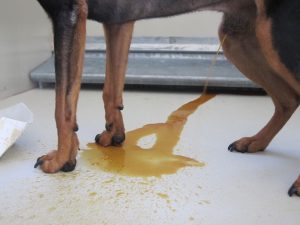Module 3: Healthcare practices for common medical conditions in shelters
Estimated Reading and Video Viewing Time: 4 hrs
It’s a Monday……
Dr. Wright has been in her new position as Medical Director at Gatorland Animal Services for a couple of weeks. She feels much more organized now that she has best practice SOPs for preventive health care and trained the vet techs and kennel staff on implementation of the procedures.
It’s Monday morning. The vet tech has just finished the Daily Medical Rounds and reports to Dr. Wright that there is a sickly looking dog in a crate in the intake room. Dr. Wright pulls up the dog’s medical record to learn more. The dog is an adult, intact, male miniature pinscher brought in to the shelter by an animal control officer on Sunday morning as a stray from the field. Here are notes the animal control officer entered into the record.
Medical Record for A17327
Picked up from yard near 123 Main St. at 8:30am Sunday
No microchip
Dog has trouble standing and has heavy breathing – seems weak but otherwise OK
Contacted supervisor about what to do with the dog
Supervisor said to leave dog in crate in the intake room with a note on the kennel card so that the vet tech would see it Monday morning
Watch This
Dr. Wright and the vet tech walked to the intake room to look at the dog. The dog was standing up struggling to breathe. (0:50 | (no audio commentary, just dogs barking in the background)
-
The dog had urinated in the crate and the urine was orange-red.
-
The dog’s gums were white.
On physical exam, the dog was thin, weak, 8-10% dehydrated, tachycardic with a grade IV holosystolic murmur, tachypneic, and had an abdominal mass that was likely an enlarged spleen. He was also covered in fleas.
Diagnostic test results: PCV=12% and TP=7.5 g/dl; heartworm antigen and microfilaria negative; numerous hookworm ova on fecal analysis.
Due to the severity of the anemia and associated clinical signs, Dr. Wright arranged for transfer of the dog to a local veterinary clinic for further testing and treatment. She asked the vet tech what the procedure was for dogs and cats with serious medical concerns brought in to the shelter at night and on weekends. The tech replied there was no procedure other than for the animal control officer to notify their supervisor for further instructions.
Dr. Wright knew that another SOP had to be created….
According to the ASV Guidelines “An emergency medical plan must be in place to provide appropriate and timely veterinary care for any animal who is injured, in distress, or showing signs of signifi
cant illness. The emergency medical plan must indicate how staff will recognize and report medical conditions requiring emergency care. The emergency medical plan should specify whether emergency services are provided on site or through an outside veterinary clinic. ”
Reflect on your own experience in shelters. How were emergencies that occurred after hours handled? Did the ACOs know what conditions warranted prompt medical care? Did they contact the shelter veterinarian or a vet tech on call? Did they have the authority to take the animal directly to a local emergency clinic instead of housing in the shelter?



